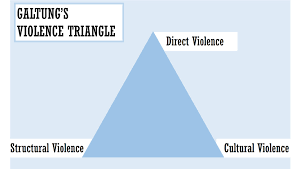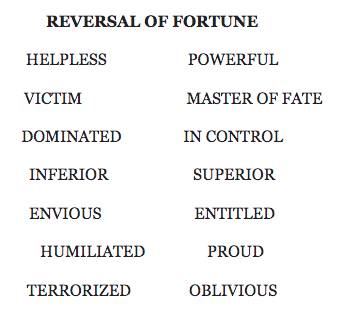Political Maturity And Rational Empathy For The Enemy – OpEd
After the breakup of the USSR, even though Putin felt it “was the greatest geopolitical catastrophe of the century,” he requested that Russia join NATO and the European Union, following proposals made by Gorbachev and Yeltsin.
“In 1994, Russia officially signed up to the NATO Partnership for Peace, a program aimed at building trust between NATO and other European and former Soviet countries. President Bill Clinton described it in January 1994 as a ‘track that will lead to NATO membership.’”
Reaching out after a humiliating defeat in hopes for peace, Putin was rebuffed.
Note: For a brief moment after the Cold War, we had a “Peace Dividend,” naively believing that the hundreds of billions spent on the nuclear arms race with the “Evil Empire” could now benefit society. About 5 minutes later the fledgling Peace Dividend was replaced with the “Rogue State Doctrine” and new, repurposed fear-mongering campaigns in search of the “enemy du jour.” In psychology, we call that “symptom substitution.”
Over decades, initiatives were rejected, including on December, 2021when Russia requested security commitments in exchange for pulling troops from the Ukraine border, and on March 17, 2022, when Putin called Turkish President Erdogan with proposals for a peace deal.
Few imagine the hopelessness and exasperation that contribute to Putin’s decisions.
Who might Putin be today had a partnership with the West been fostered? Would he still be the implacably evil new Hitler?
“Any analysis that confines itself to Russia’s actions alone, or that looks no further than the inside of Putin’s head, is at best a one-sided delusion, and at worst willfully distorts the facts.” Tony Wood, MATRIX OF WAR
“Never fight evil as if it were something that arises totally outside of yourself.” — St Augustine
See:
- Why is Ukraine the West’s Fault? John Mearsheimer talk from 2015
- Vladimir Pozner: How the United States Created Vladimir Putin. 10/2/2018
- John Mearsheimer on War in Ukraine with Katrina vanden Heuvel, Ambassador Jack Matlock, and more, April 7,2022
The 13th Fairy Syndrome
A common archetypal motif in fairy tales – when the queen gives birth a gala celebration is held for the whole kingdom. Twelve fairies are invited. The uninvited 13th fairy, upon rejection, places a curse on the princess and the entire kingdom.
DMA vs. HDT
Humiliation, rejection, and threats fuel a deep unconscious, cultural script Johan Galtung calls Dualism-Manicheism-Armageddon (DMA). We have been tragically plunged into a compelling, simplistic, archetypal narrative of us/them, right/wrong, good and evil characterized by psychological splitting and immature, concrete, black-and-white, all or nothing, zero sum thinking. With the nuclear threat, “Armageddon” is not just a metaphor.
A constructive response to any of Russia’s requests would have supported conscious evolution to the mature, conscious script of Holism-Dialectics-Transcendence (HDT). The opportunity to apply the Transcend Method to overcome 50 years of dualism was lost.
Regression into DMA is a manifestation of negativity dominance, requiring consciousness to overcome. Jung describes consciousness as a “work against nature,” an “opus contra naturum.”
Repeated rejection created conditions conducive to Direct Violence = Cultural Violence, DMA + Structural Violence, including exclusion, humiliation, asymmetrical power dynamics, encirclement with continuing waves of NATO expansion.
Gripped by the Script
Each side is gripped by its own narrative. The West’s is “.. a simple Hollywood script: Ukraine is the angel, Russia is the devil, Zelensky is the hero and all good people will wear blue and yellow ribbons.”(All Things Russian are Being Punished”. Fueling the Propaganda War
This framing invites policies to defeat evil with flowing weapons, crippling, biting sanctions, increasing pressure, escalating existential threats of total defeat and destruction.
Encirclement Informs Russia’s Script
We are oblivious to real and perceived threats to Russia’s security concerns.
Symbolic Example: On March 18, 2022, four US marines were killed in a NATO military exercise in a Norway Northern Mountainous area unrelated to the Russia-Ukraine war, during a military drill, called “Cold Response” which happens every 2 years. It ran from March 14 to April 1. The drill included 30,000 troops, 220 aircraft and 50 vessels from 27 countries. Non-NATO members Finland and Sweden participated.
Symbolic synchronicities:
- Marines crashed in an American MV-22 Osprey aircraft with its troublesome accident history, politically controversial for decades.
- The crash occurred on the anniversary of the cataclysmic US led “shock and awe” invasion of Iraq. This might be an example to Putin.
Also, Pankaj Mishra posits “an opportunity to make America seem great again” following demoralizing “Humiliation in Iraq and Afghanistan, and at home by Trump.”
Consider convergence of themes as synchronistic messages from the universe.
Since then, Sweden and Finland ask to NATO, falsely believing it will make them more secure.
Psychological Ignorance, Political Malpractice and Nuclear Provocation
Backed into a corner, Putin raised the nuclear threat.
Pundits and politicians glibly make dangerous, psychologically ignorant claims with bravado and certainty about how policies work. Jan Olberg calls them “conflict illiterate.”
Many believe in forms of pressure and coercion – sanctions, deterrence, isolation, punishments, threats, and violence to make the enemy bend to our will, despite policies having a poor track record, even provoking an opposite effect.
Deterrence is a theory, not a guarantee. It breaks down under certain conditions, flipping into spiral dynamics of provocative mutual escalation, in “self-fulfilling paranoia.™”
Deterrence threatens overwhelming violence to control a state’s behavior. “Nuclear deterrence is a scheme for making nuclear war less probable by making it more probable.” former Royal Commander Rob Green, The Naked Nuclear Emperor.
Psychologist Ralph K White empathizes that deterrence only works when accompanied by drastic tension reduction.
Here are a few examples of dangerous FIBS™, Falsely Informed Belief Systems:
“A universal feature of the enemy image is that the enemy can be influenced only by force.” Jerome Frank and Andrei Melville
“I think if it’s going to deter Putin, we shouldn’t rule anything out. And I’m among those who say we should keep Putin in maximum uncertainty.” Anders Fogh Rasmussen, Danish PM, former NATO Secretary-General, from Jan Olberg,
Evelyn Farkas on PBS News Hour with Judy Woodruff, May 5:
“Again, I think he’s most likely to use them, Judy, if he feels that there will be no consequences for him, if he thinks that we will not counter with a nuclear use — I know it’s a horrible thing to contemplate, but that is how deterrence works — or if he thinks that we will not enter the war directly. …. So, I think that Vladimir Putin is likely smart enough to understand the danger for himself. He’s not going to reach for a nuclear weapon right now.”
In contrast to John Mearsheimer,
“I think, Judy, this policy that the Biden administration is following is remarkably dangerous and foolish. …. And what the Biden administration is bent on doing is inflicting a decisive defeat on Russia. We are threatening its survival. We are presenting the Russians with an existential threat. And this, again, is the one circumstance where they might use nuclear weapons.”
Psychiatrist Vamik Volkan claims some would rather die physically than psychologically. Some choose defiance and death rather than back down as in “Give me liberty or give me death” and “Better Dead than Red”
Fear
People are more dangerous when afraid, as are we.
“The madness that is carrying the world closer and closer to nuclear war has at its core a psychological explanation: Each side, though fundamentally afraid, misperceives the nature of the danger it faces. Each side imagines that it faces an inherently, implacably aggressive enemy, when it actually faces an enemy as fearful as itself – an enemy driven mainly by fear, to do the things that lead to war.” — Ralph K. White, Fearful Warriors.
White differentiated between healthy, realistic fear and unhealthy, exaggerated fear of a diabolical enemy image, combined with macho pride.
The Mirror Image of the Enemy
In the 1950s, social psychologist Uri Bronfenbrenner observed that Soviets and Americans said the same positive things about themselves and negative things about the Other. We are noble, just and true. They are innately hostile, evil and aggressive.
Making the “ultimate attribution error,” each explains their own behavior as motivated by circumstances (we are peace-loving but have to build arms because of them). The enemy’s behavior is because of who they are.
In “Empathizing with the Rulers of the USSR” 1983, White said, “Recent history, psychologically interpreted, suggests that Soviet foreign policy is mainly defensive in motivation. In this respect, the mirror-image concept is valid. The horrors of World War I still dominate Soviet minds, including those of its leaders”
See A Psychological Profile of U.S.-Soviet Relations – 1984 29 minutes
Nuclear expert Zia Mian said, “It is deterrence when you do it, but it is blackmail when it is done to you.”
Preventing Armageddon in the 21st Century, Morton Deutsch, Ph.D.
Deutsch describes a “Malignant Spiral of Hostile Interaction.” Each side believes that they absolutely must win.
Excerpts
A win-or-lose orientation tends to escalate conflicts.
- communication is impaired, reinforcing existing stereotypes and encouraging misinformation and error;
- the opponents become more suspicious of each other, more sensitive to difference and threats, and
- each party becomes convinced that a solution to the conflict can only be found through superior force or by outwitting the antagonist.
Thus, disputes over specific issues that might be resolved to the satisfaction of both parties become struggles solely for superior power.
Malignant conflicts encourage misperception and misjudgments that yield unwanted results.
As the conflict escalates, the actions taken by each party commit each more deeply to policies that perpetuate the conflict; the opponents thus become locked into their positions of self-interest rather than open to exploring mutually desirable policies and programs. Information communications and contact, which might mitigate the conflict, are reduced. All parties become so focused on winning that they readily lose sight of their basic interests ..
Psychological experiments suggest that when one party in a conflict attempts to increase its security without regard for the security of the other party, the attempt readily becomes self-defeating. Such a situation is potentially catastrophic when the stakes involve nuclear war. If military inferiority is dangerous, so is superiority. It is dangerous for either side in a conflict to feel tempted or frightened into action, or to have grounds to believe that its antagonist might be so tempted or frightened. According to this analysis, our security and that of an adversary can only be obtained through our mutual security.
Intersubjectivity, Role Reversal, and Perversion of the Desire for Empathy
When parties are in an intense psychic relationship, with trauma, intolerable affects can be evacuated from the self and deposited into another through an unconscious mechanism called projective identification. Perhaps a perverse form of empathy, this transforms the subjective experience of the recipient.
Consider actions to overcome intolerable, inescapable feelings of humiliation and domination, combine projective identification and regressive restoration of the persona to reverse roles.
Therefore, “If we in the West want to survive, by avoiding nuclear war, it behooves us to empathize realistically with the rulers of the Soviet Union.” (now Russia) — Ralph K. White
Solutions
Solutions include realistic empathy, drastic tension reduction, Charles Osgood’s GRIT – Graduated Reciprocated Initiatives in Tension Reduction, communication, problem-solving, creative, win-win strategies, and creative arrangements for balancing identity, dignity, safety, autonomy and sovereignty. It is challenging to escape the pull of primitive emotions.
The conclusion I always reach is that bodies of knowledge in fields of conflict transformation and peace studies that possess analysis, understanding, and solutions essential to our survival are virtually unknown or misunderstood where needed most.
We must do all we can to raise consciousness, educate and participate in policy design.
*Diane Perlman, PhD is a clinical and political psychologist, devoted to applying knowledge from psychology, conflict studies and social sciences to designing strategies and policies to reverse nuclear proliferation, to drastically reduce terrorism, reduce enmity, and to raise consciousness about nonviolent strategies for tension reduction and conflict transformation. She is a visiting scholar at the School for Conflict Analysis and Resolution at George Mason University, is active in Psychologists for Social Responsibility, the TRANSCEND Network for Peace Development Environment, and on the Global Council of Abolition 2000. Some of her writings can be found on her websites, www.consciouspolitics.org and www.SanityandSurvival.com. Email: [email protected]
This article originally appeared on Transcend Media Service (TMS)



